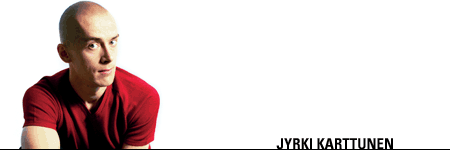 POSITIVE AND NEGATIVE CHARGES
POSITIVE AND NEGATIVE CHARGES
Jyrki Karttunen's mind is occupied at regular intervals by positive and negative charges: judgements considered to be self-evident about matters like goodness, profundity and authenticity. For example, the artist, who speaks on behalf of polyphony, makes his work the pondering of whether things appreciated and understated, when combined in a new way, will make an impression of strangeness or whether they may simply just exist as they are.
As a choreographer, Karttunen strives for polyphony by many different means: by uniting so-called high culture and more popular art into one. By playing in earnest, in other words. The choreographies combine the movement-arsenal of contemporary dance, the images of Spanish culture inspired by the films of Pedro Almodóvar as well as, for example, tap dance, often considered a rather light genre, as a symbol of states of mind or as estranged images of our times.
When he was making his solo work Keiju (Fairy, 2002), the artist paused to think why he chose dance as his means of expression: "I remember when as a young man I turned from sculpture to dance. I want to create a form for something for which I don't need words, as it doesn't yet exist in such a form. Now I have discovered how one can have three different views in movement at the same time. In my opinion, as a phenomenon it corresponds most naturally to thought.'
Dancing has become a bodily form of thinking
"When one creates miniature cosmoses one also has to create the god-figure. One can, however, try to use this situation in order to construct a world which on a very personal level one thinks people need and of course in order to construct for oneself and give form to matters one would like to understand."
In the course of his career Jyrki Karttunen has created much first-rate, powerfully expressive work, including his work as a dancer at the Helsinki City Theatre Dance Company from 1989 to 1993, as a guest performer at the Finnish National Opera and under the direction of many well-known choreographers, such as Jorma Uotinen, Marjo Kuusela and Carolyn Carlson. With his view of the world changing at least four times a year, the artist gradually acquired an enthusiasm for throwing himself into creating his own virtual worlds, in his own rhythm.
"As a dancer so many physical beings have moved about in me that right from the start of my work as a choreographer it has been relatively easy to make choices."
Karttunen began the making of dance universes in 1995. That was the turning point at which in the words of the creator his creation leapt out of his hands. He himself considers his career as a choreographer to have really begun in 1998, when he completed the highly praised choreography Digital Duende, which has been performed successfully not only in Finland but also, for example, in Australia, Spain, South Africa and Great Britain. Excellent feedback has also come from Keiju (Fairy, 2002), Alla (Under, 2001) and Mr & Mrs Betlehem (2000). In his work, Karttunen has moved increasingly from being a dancer to being a choreographer, but dancing is and remains the starting point for his activity.
"The worlds I create always bounce back to the performer at some level. Probably partly because I myself am a performer and also because I'm interested in creating complete characters. My emphasis is on people and the nuances of people's movements. I go to a lot of trouble to be 'different' from others."
Karttunen is pleased that little by little dancers have also increasingly become more independent artists who can have their own opinions. Thus, the dancer inevitably brings to the work something that the choreographer has not been able to construct in its entirety. For the choreographer Karttunen, the work is based in the dancer's desire to play and create worlds. The choreographer's task is to be a helper.
Since the framework of action can be seen both as a scene and as something in the nature of a sandbox, it starts to be difficult to judge what is unambiguously right or wrong, good or bad, true or fictitious. The dancer and choreographer Kartttunen has chosen to dedicate everything to this action, as he feels at his best and happiest when he is dancing.
Text by Hannele Jyrkkä
Translated by David McDuff
 POSITIVE AND NEGATIVE CHARGES
POSITIVE AND NEGATIVE CHARGES